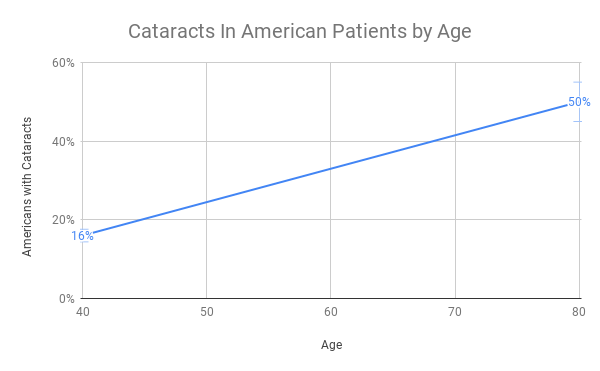Understanding Cataracts can lead to earlier detection and treatment.
Cataract refers to the cloudy film that grows on the lens of the eye and impairs vision. This is not a new disease, with evidence pointing to the existence of cataracts as early as 2000 BC in Egypt.
Today, cataracts are a common disease affecting 24.4 million Americans above the age of 40, or 1 in 6 people for that age group.
By the age of 80 half of Americans have developed cataracts.Most cataracts develop as a result of aging, but certain factors such as medical conditions, certain medications, extended UV Ray exposure and other eye diseases can encourage the growth of cataracts.
There are several types of cataracts. Some progress very slowly, taking years before they are developed enough to hinder vision, while others can become problematic much sooner. Some cataracts may never progress out of the early stages of the disease, but others can hinder everyday activities such as driving or working by impairing vision.
Understanding the stages of the disease not only identifies the best treatment options, but also teaches symptoms to watch for. Milder cataracts caught in developing stages can be treated with updated prescription glasses that prevent further development. If a cataract has already progressed to the more advanced stages, surgery may be required to remove the lens. Learn more about cataract surgery here.
Let’s break down the stages of cataract development and identify symptoms to better understand how cataracts progress. If you are experiencing any of the following symptoms, schedule a consultation immediately.
Early Stages
When cataracts first form they rarely impact vision directly. In these early stages you may see a cloudy area beginning to form on your eye. As the cataract advances, so does the intensity of the symptoms. These slow progression of symptoms can make them difficult to notice. In the early stages of the diseases you may experience:
- Blurred Vision
- Double Vision
- Glares from Lights
- Trouble adjusting from a dim room to a light one
- Difficulty seeing in the dark.
- Fading or Browning of Colors
- Halos around lights
If diagnosed in the early stages, cataracts can be treated with prescription glasses and improved light conditions. However, cataracts generally go undiagnosed until they are impacting vision significantly.
Advanced Stages
As the disease progresses some symptoms intensify while others fade or disappear. For example, in advanced stages of the disease you no longer experience double vision, but colors fade substantially more. Other symptoms present in this stage include:
- Larger Halos around lights
- Increased Glare from Lights
- Blurrier or cloudy vision
- Visible white spots on the lens of your eye
- White or yellowish film on the eye
- Vision Loss
- Fading Colors
- Difficulty seeing in the dark.
- Trouble adjusting from dim lights to bright ones.
- Trouble reading in dim light
Once a cataract reaches the advanced stages surgery is needed to rectify your vision. In extremely advanced cases, the cataract can spread, causing permanent damage to the eye. Seek treatment as soon as possible for the best results. Generally, you will see a complete restoration in your vision after the operation.
Cataract Surgery
Cataract surgery is one of the safest and most common procedures performed today. The cloudy lens is removed and replaced with a new lens. The operation itself only takes around 20 minutes and does not require an overnight stay. At Vision Quest Medical Center, we use the latest technology to ensure the safest and most comfortable experience possible for our patients.
Today’s cataract surgery is a bladeless procedure using lasers, a safer and more effective procedure than traditional methods. Dr. Mong and his team test the new lens in real time, making any needed changes without having to schedule a new operation. After the surgery, most clients see their vision improve as soon as the next day, with additional improvements over the next several weeks.
If you are experiencing any of the symptoms above we encourage you to make an appointment immediately to stop progression of the cataract. Our expert ophthalmologists will examine your eye and recommend the safest and most effective treatment method available.
Have more questions about cataracts? In the video below, Dr. Mong explains how cataracts develop:






